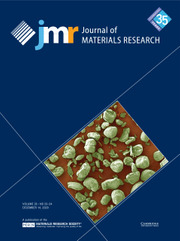Crossref Citations
This article has been cited by the following publications. This list is generated based on data provided by
Crossref.
Godart, C.
Alleno, E.
Tominez, E.
Gupta, L.C.
Nagarajan, R.
Hossain, Z.
Lynn, J.W.
Bonville, P.
Hodges, J.A.
Sanchez, J.P.
and
Felner, I.
1997.
Some Chemical and Physical Properties of Quaternary Borocarbides.
Journal of Solid State Chemistry,
Vol. 133,
Issue. 1,
p.
169.
Nagarajan, R.
1997.
Superconductivity and magnetism in quaternary borocarbides.
Journal of Low Temperature Physics,
Vol. 107,
Issue. 5-6,
p.
517.
Nagarajan, R.
1997.
Quaternary borocarbides — exotic superconducting and magnetic materials.
Physica C: Superconductivity,
Vol. 282-287,
Issue. ,
p.
69.
Maple, M.Brian
de Andrade, Marcio C
Herrmann, Jan
Dickey, Robert P
Dilley, Neil R
and
Han, Seungho
1997.
Superconductivity in rare earth and actinide compounds.
Journal of Alloys and Compounds,
Vol. 250,
Issue. 1-2,
p.
585.
Szillat, H.
Kuhn, H.
Schuster, Th.
Majewski, P.
Seeger, M.
Aldinger, F.
and
Kronmüller, H.
1997.
Magnetic phase transitions and structural deficiencies in superconducting YNiBC.
Physica C: Superconductivity,
Vol. 280,
Issue. 1-2,
p.
43.
Behr, G.
Löser, W.
Graw, G.
Nenkov, K.
Krämer, U.
Belger, A.
and
Wehner, B.
1999.
Phase relations and superconducting properties of the Y–Ni–B–C system.
Journal of Materials Research,
Vol. 14,
Issue. 1,
p.
16.
Ledig, L
Hough, D
Oertel, C.-G
Eckert, J
and
Skrotzki, W
1999.
Nanocrystal formation, amorphization and superconductivity in YNi2B2C.
Journal of Alloys and Compounds,
Vol. 285,
Issue. 1-2,
p.
27.
Tominez, E.
Alleno, E.
Berger, P.
Bohn, M.
Mazumdar, Chandan
and
Godart, C.
2000.
Chemical and Superconducting Properties of the Quaternary Borocarbides Ln–M–B–C (Ln=rare earths, Y; M=Ni, Pd).
Journal of Solid State Chemistry,
Vol. 154,
Issue. 1,
p.
114.
Dezaneti, L.M
Xue, Y.Y
Sun, Y.Y
Ross, K
and
Chu, C.W
2000.
Direct identification of the 23 K superconducting phase in the Y–Pd–B–C system.
Physica C: Superconductivity,
Vol. 334,
Issue. 1-2,
p.
123.
Alleno, E.
Berger, P.
Leroy, E.
and
Godart, C.
2001.
Rare Earth Transition Metal Borocarbides (Nitrides): Superconducting, Magnetic and Normal State Properties.
p.
265.
Nagarajan, R.
2001.
Rare Earth Transition Metal Borocarbides (Nitrides): Superconducting, Magnetic and Normal State Properties.
p.
1.
Bitterlich, H
Löser, W
Lindenkreuz, H.-G
and
Schultz, L
2001.
Superconducting YNi2B2C- and YPd2B2C-phase formation from undercooled melts.
Journal of Alloys and Compounds,
Vol. 325,
Issue. 1-2,
p.
285.
Pickett, W.E.
2001.
The other high-temperature superconductors.
Physica B: Condensed Matter,
Vol. 296,
Issue. 1-3,
p.
112.
Bitterlich, H
Löser, W
and
Behr, G
2002.
Constitution and superconductivity of Y(NixPd1−x)2B2C alloys.
Materials Letters,
Vol. 57,
Issue. 1,
p.
59.
Nagarajan, R.
Mazumdar, Chandan
Hossain, Z.
and
Gupta, L.C.
2005.
Frontiers in Superconducting Materials.
p.
393.
Niewa, Rainer
Shlyk, Larysa
and
Blaschkowski, Björn
2011.
Rare-earth metal transition metal borocarbide and nitridoborate superconductors.
Zeitschrift für Kristallographie,
Vol. 226,
Issue. 4,
Mazumdar, Chandan
and
Nagarajan, R.
2015.
Quaternary borocarbides: Relatively high T intermetallic superconductors and magnetic superconductors.
Physica C: Superconductivity and its Applications,
Vol. 514,
Issue. ,
p.
173.
Kobayashi, Kaya
Horigane, Kazumasa
Horie, Rie
and
Akimitsu, Jun
2019.
Physics and Chemistry of Carbon-Based Materials.
p.
149.

